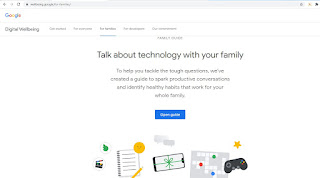What is Digital Wellbeing ?
Digital wellbeing is a term used by health professionals, researchers and device manufacturers to describe the concept that when humans interact with technology, the experience should support mental and/or physical health in a measurable way. The goal of improving digital wellbeing is to design technology in such a way that it promotes healthy use and proactively assists the user to maintain a healthy lifestyle.
As a response to a call for apps and technology that respect a person's time, some companies developed features that are less disruptive or added the ability to turn off distracting notifications. In addition, companies created new apps that track digital wellbeing keep record of things like amount of screen time spent on different apps. They help the user to lower undesired types of screen time, or to be more deliberate about how technology is used.
Digital wellbeing considerations
When optimizing digital health, multiple health-related components can be taken into consideration. This can include:
- Limiting screen time to a certain number of minutes or hours over the course of a day or week.
- Reducing eye strain in frequent device users. Products such as dark panels that cover screens or special lenses that go over glasses to reduce glare have been developed to aid with eye strain. Recommendations also exist for how large information on the screen should be, what settings and resolution should be implemented, how often eyes need to be rested and what the optimal distance is between eyes and the screen.
- Being aware of unforeseen mental health impacts. One example of an adverse feature to mental health is the endless scroll addition to social media platforms like Facebook and Instagram. This has been attributed to internet addiction which has been correlated with high levels of anxiety, ADHD, depression, poor time management and impulsiveness.
- Increasing emphasis on physical activity and nutrition. Many technological devices have been developed to help devices users bring up fitness levels, track heart rate, report daily step count and monitor diet.
- Supporting healthy sleep patterns, especially for users that bring devices with them to bed. Users can set their devices to turn off certain features at bedtime or change the screen contrast or switch to grayscale to reduce eye strain. For example, the iPhone includes a built-in feature that reminds users to go to sleep at a certain time.
Examples of digital wellbeing tools
Various tools have been created to increase digital wellbeing, such as:
- Website blockers that allow users to block certain websites, either at all times or during certain time intervals, to decrease distraction and increase productivity. An example of a website blocker is the tool Cold Turkey.
- Usage dashboards, like the one integrated into the Android OS, that track how many hours a user spends on different apps or websites. This can be used to limit or track average use.
- App timers that limit how many minutes or hours a user can spend on certain website or applications per day. These can also be used to restrict access after a certain time of day.
- Google Shush is a feature that switches a device to "do not disturb" mode whenever it is placed screen down and Google Wind Down is a feature that flips the screen to grayscale at a specified bedtime.
https://whatis.techtarget.com/definition/digital-wellbeing












